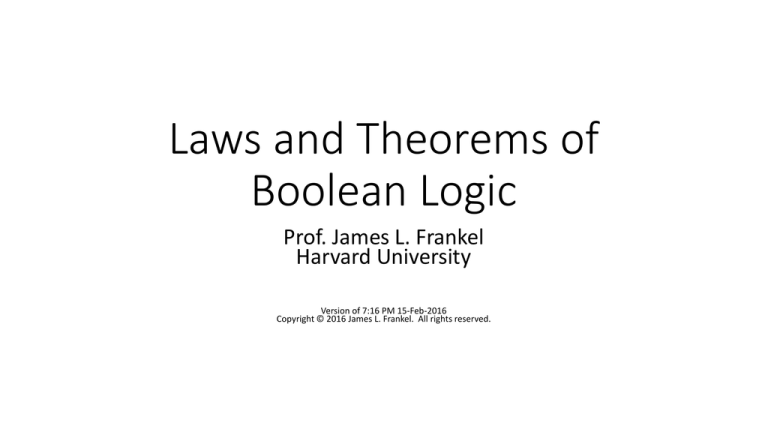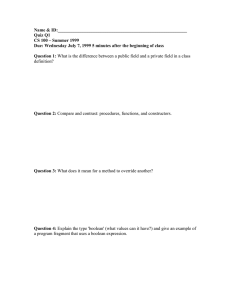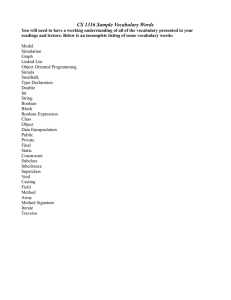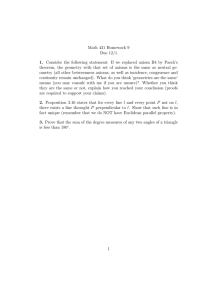
Laws and Theorems of
Boolean Logic
Prof. James L. Frankel
Harvard University
Version of 7:16 PM 15-Feb-2016
Copyright © 2016 James L. Frankel. All rights reserved.
Axioms of Boolean Algebra (1 of 4)
• Axiom 0
• Set of elements, B
• Two binary operators, + and ·
• One unary operator, ‘
• Axiom 1
• Set B contains at least two element a and b s.t. a ≠ b
Axioms of Boolean Algebra (2 of 4)
• Axiom 2 – Closure
• For every a and b in B,
• a + b is in B
• a · b is in B
• Axiom 3 – Commutative laws
• For every a and b in B,
• a+b=b+a
• a·b=b·a
Axioms of Boolean Algebra (3 of 4)
• Axiom 4 – Associative laws
• For every a, b, and c in B,
• (a + b) + c = a + (b + c) = a + b + c
• (a · b) · c = a · (b · c) = a · b · c
• Axiom 5 – Identities
• There exists an identity element with respect to +, designated by 0, s.t.
• a + 0 = a, for every a in B
• There exists an identity element with respect to ·, designated by 1, s.t.
• a · 1 = a, for every a in B
Axioms of Boolean Algebra (4 of 4)
• Axiom 6 – Distributive laws
• For every a, b, and c in B,
• a + (b · c) = (a + b) · (a + c)
• a · (b + c) = (a · b) + (a · c)
• Axiom 7 – Complement
• For each a in B, there exists an element a' in B (the complement of a) s.t.
• a + a' = 1
• a · a' = 0
Order of Evaluation of Boolean Expressions
• In a Boolean expression without parentheses,
• Complement is always applied first
• then, AND is applied
• finally, OR is applied
• Operations in sub-expressions within parentheses are always applied
before operations between parenthesized expressions
• Equivalently, we say that parentheses have highest precedence,
followed by complementation, followed by AND, then finally by OR
Literals and Simplification
• In a Boolean expression, each variable in either its noncomplemented or complemented form is called a literal
• If E1 and E2 are two expressions for the same Boolean function (i.e.,
they have the same truth table), we say that E2 is simpler than E1 if it
contains fewer literals
Duality
• Every expression in Boolean logic has a dual expression that is formed by
• Replacing every AND operator by an OR operator, and vice versa
• Replacing every constant 0 by 1, and vice versa
• Be sure to not change the order of operations when replacing AND by OR and vice versa (i.e.,
assume every operation is parenthesized)
• For every statement of Boolean logic that is true, its dual is also true
• For example, x + 0 = x is true
• (x + 0 = x)D which is x · 1 = x is also true
• In the following laws and theorems, we will present the dual with a D suffix
Observation on Duality
• Does duality remind you of active-high vs. active-low logic?
• It should!
Other Theorems That Can be Derived from
the Laws and Theorem Above
• All of the Theorems that follow can be derived from the Axioms,
Laws, and Theorems given above
Operations with 0 and 1
• 1. x + 0 = x
• 1D. x · 1 = x
• 2. x + 1 = 1
• 2D. x · 0 = 0
Idempotent Theorem
• 3. x + x = x
• 3D. x · x = x
Involution Theorem
• 4. (x')' = x
Theorem of Complementarity
• 5. x + x' = 1
• 5D. x · x' = 0
Commutative Law
• 6. x + y = y + x
• 6D. x · y = y · x
Associative Law
• 7. (x + y) + z = x + (y + z) = x + y + z
• 7D. (x · y) · z = x · (y · z) = x · y · z
Distributive Law
• 8. x · (y + z) = (x · y) + (x · z)
• 8D. x + (y · z) = (x + y) · (x + z)
Simplification Theorems
• 9. x·y + x·y' = x
• 9D. (x + y) · (x + y') = x
• Notice the insertion of parentheses to ensure that the order of operations has not
changed
• 10. x + x·y = x
• 10D. x · (x + y) = x
• Once again, notice the insertion of parentheses to ensure that the order of
operations has not changed
• 11. (x + y') · y = x·y
• 11D. x·y' + y = x + y
DeMorgan’s Law
• 12. (x + y + z + …)' = x' · y' · z' · …
• 12D. (x · y · z · …)' = x' + y' + z' + …
General Form of DeMorgan’s Law
• 13. {f(x1, x2, …, xn, 0, 1, +, ·)}' = f(x1', x2', …, xn', 1, 0, ·, +)
Duality
• 14. (x + y + z + …)D = x · y · z · …
• 14D. (x · y · z · …)D = x + y + z + …
General Form of Duality
• 15. {f(x1, x2, …, xn, 0, 1, +, ·)}D = f(x1, x2, …, xn, 1, 0, ·, +)
Theorem for Multiplying and Factoring
• 16. (x + y) · (x' + z) = x·z + x'·y
• 16D. x·y + x'·z = (x + z) · (x' + y)
Consensus Theorem
• 17. x·y + y·z + x'·z = x·y + x'·z
• 17D. (x + y) · (y + z) · (x' + z) = (x + y) · (x' + z)





